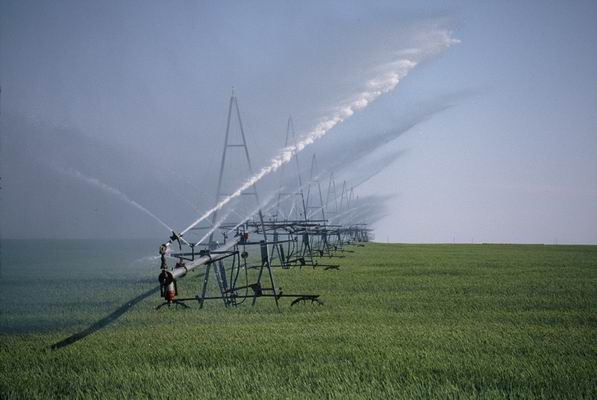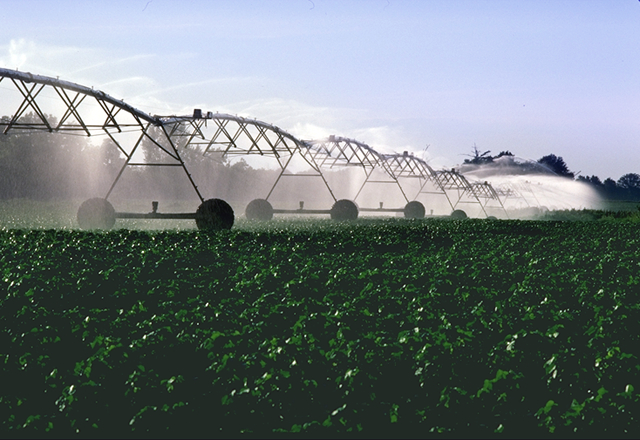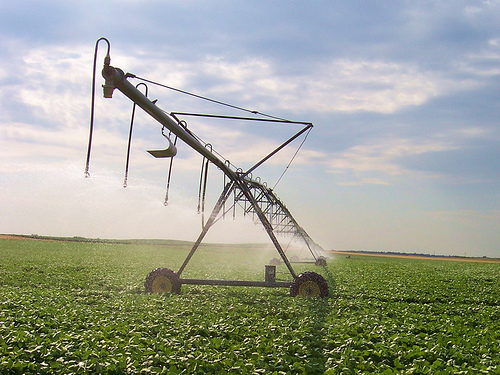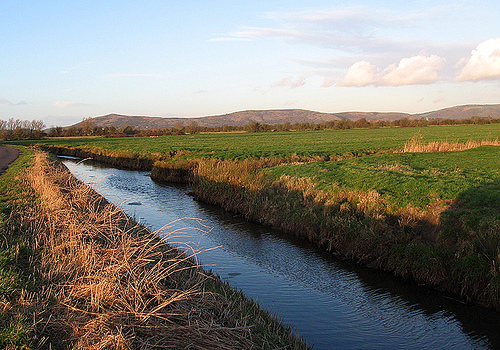Lesson: Way to Flow — Water Irrigation
(Lesson courtesy of TryEngineering)
Lesson Plan pdf.
Grade Level: 6-12
Time Needed: Two to three 45-minute sessions
Lesson Focus: Through the centuries, man has needed to move water from one place to another. Engineered irrigation has proved critical throughout the world. In this lesson, students work in teams to design and build a system to move water from one source to two different delivery areas.
Overview: This lesson explores how civil engineering has solved the challenge of moving water via irrigation. Students learn how irrigation systems direct water for use in farming or other purposes. Using everyday items, each team of students designs and builds an “irrigation system” capable of moving two cups of water at least three feet and distributing it evenly in two separate containers. Students develop a plan, build and test their system, and then evaluate the effectiveness of their and other teams’ efforts. Finally, they present their findings to the class.
National Science Education Standards Grades K-4 (ages 4 – 9)
CONTENT STANDARD A: Science as Inquiry – develop abilities necessary to do scientific inquiry
CONTENT STANDARD B: Physical Science – develop an understanding of properties of objects and materials
CONTENT STANDARD E: Science and Technology – develop abilities of technological design, understanding about science and technology abilities to distinguish between natural objects and objects made by humans
CONTENT STANDARD F: Science in Personal and Social Perspectives – develop understanding of types of resources, changes in environments, science and technology in local challenges
CONTENT STANDARD G: History and Nature of Science – develop understanding of science as a human endeavor
National Science Education Standards Grades 5-8 (ages 10 – 14)
CONTENT STANDARD A: Science as Inquiry – develop abilities necessary to do scientific inquiry
CONTENT STANDARD B: Physical Science – develop an understanding of motions and forces
CONTENT STANDARD E: Science and Technology – develop abilities of technological design
CONTENT STANDARD F: Science in Personal and Social Perspectives – develop understanding of populations, resources, environments risks and benefits, science and technology in society
CONTENT STANDARD G: History and Nature of Science – develop understanding of science as a human endeavor
National Science Education Standards Grades 9-12 (ages 14-18)
CONTENT STANDARD A: Science as Inquiry – develop abilities necessary to do scientific inquiry, understandings about scientific inquiry
CONTENT STANDARD B: Physical Science – develop understanding of motions and forces, interactions of energy and matter
CONTENT STANDARD E: Science and Technology – develop understandings about science and technology
CONTENT STANDARD F: Science in Personal and Social Perspectives – develop understanding of personal and community health, natural resources, environmental quality, natural and human-induced hazards, science and technology in local, national, and global challenges
CONTENT STANDARD G: History and Nature of Science – develop understanding of science as a human endeavor and historical perspectives
More standards for this lesson can be found here.
Lesson Objectives: To learn about civil engineering, engineering design, planning, construction, teamwork, and working in groups.
Materials
- • Student Resource Sheet and Worksheets
- • Water basin and water for testing student irrigation systems
- • One set of materials for each group of students: Straws, cardboard or paper cups or bowls, clay, tubes, aluminum foil, rubber bands, tape, jars, toothpicks, glue, paperclips, plastic piping, tape, and other materials
Procedure
1. Show students the various Student Reference Sheets. These may be read in class, or provided as reading material for the prior night’s homework.
2. Divide students into groups of 2-3 students, providing a set of materials per group.
3. Explain that students must work as a team to design an irrigation system to move two cups of water a distance of at least three feet. The team has a goal of splitting the water into two separate containers of exactly one cup each.
4. Students meet and develop a plan for their irrigation system. They draw their plan, and then present their plan to the class.
5. The teams next execute their plans. They may need to rethink their design, or even start over.
6. Next, teams will test their irrigation system to see how it works. Students will measure how much water is gathered in each of the two destination containers and see how close their water is to the goal of one cup in each container. The teams may test their systems three times and count the most successful test.
7. Teams then complete an evaluation/reflection worksheet, and present their findings to the class.
Tips: Students may require additional materials from the teacher, or they may be encouraged to exchange building materials with other teams.
Extension Ideas: Older students might undertake the challenge to split the water into three destination containers or to adjust the ratio of water between the two destination containers to 75% and 25% instead of 50% and 50%.
If more time is available, have students consider designing the most complicated irrigation system they can imagine, along the lines of a Rube Goldberg machine — performing a simple task in a complex way.
Also consider setting a budget for the project, assigning a cost to each material, and requiring teams to “buy” materials from the teacher to create their irrigation system.

Optional Writing Activity: Write an essay describing how irrigation impacts life in South Africa, where “water poverty” is widespread and a third of the country’s 36 million people do not have adequate supplies of drinking water.
Student Resource
What is Irrigation?
Irrigation is a system that artificially routes water to an area where it is not naturally present. More common applications are in providing water to remote or dry land for growing crops. Irrigation is frequently used to compensate for periods of anticipated or emergency drought, but also is used to protect plants against frost. Irrigation systems are also used to help suppress the growth of weeds in rice fields. There are many different irrigation techniques to route water from a source to its destination. Usually, uniformity in water placement is a goal, especially for growing crops.
Irrigation History
Archaeologists have found evidence of irrigation at work in Mesopotamia and Egypt as far back as the 6th millennium BCE, where barley was being grown in areas where the natural rainfall was inconsistent or not necessary sufficient to support the crop. In the Zana Valley of the Andes Mountains in Peru, archaeologists have found the remains of three irrigation canals which were radiocarbon dated to place their development at the 4th millennium BCE, the 3rd millennium BCE, and the 9th century CE. At the moment, these canals are considered the earliest examples of irrigation systems found. In addition, advanced irrigation and water storage systems were developed by the Indus Valley Civilization in Pakistan and North India. Because extensive agriculture was required, an innovative network of canals was developed to support irrigation. There also is evidence of the ancient Egyptian pharaoh Amenemhet III in the twelfth dynasty using the natural lake of the Faiyum Oasis as a reservoir to store water to be used during dry seasons. The lake would swell annually due to the annual flooding of the Nile River. Egypt received little rainfall, so the Nile was a logical source of water.
Roman Aqueducts
The ancient Romans constructed many aqueducts to route water to cities and other sites. These aqueducts are considered to be one of the greatest engineering feats of the ancient world. Many of the ancient aqueducts are still in use today. They served several functions including providing potable water and supplying water to baths and fountains. Water was then routed into the sewers, where they helped remove waste matter.
Ethical Implications
Irrigation can route water to fields, help crops overcome drought, provide drinking water, and support waste removal. But, how do engineers and others decide which use of water is the most important? What are the ethical considerations that must be reviewed to strike a balance of fairness? For example, what if one farmer routed a river to serve his or her own crops and in doing so prevented his neighbors from receiving any river water? Or, if water was routed to a company that stood to make a great deal of money from a profitable manufacturing facility, but in order to provide enough water for their process, all water would be diverted from small local farms farmers who might lose their livelihood. What would be fair?
Engineers are continually faced with ethical considerations when building structures, designing systems, and improving products. Engineering does not have a single standard for ethical conduct because approaches vary somewhat by discipline. For example, a biomedical engineer might be concerned with respecting the feelings of a patient, or would want to pay particular attention to the reliability of a product such as an artificial heart. A civil engineer would consider safety and strive to develop a bridge that is not only safe, but also cost effective. A bridge could be over constructed, be safer than it would ever need to be, and be over budget as well.
Question
Can you think of an example of how a team of engineers might have to address ethical considerations related to the environment when building an irrigation system? What do you think the team would have to investigate before starting construction?
Student Worksheet
Design Your Own Irrigation System: You are part of a team of engineers who have been given the challenge of developing an irrigation system that will carry two cups of water a distance of three feet and split the water into two separate destination containers. If your system works, you’ll end up with exactly one cup of water in each of your destination containers. How you accomplish the task is up to your team!
Planning Stage: Meet as a team and discuss the problem you need to solve. Then develop and agree on a design for your irrigation system. You have been provided with many items you may use to construct your system. As a team, come up with a plan, and draw your design in the box below. Be sure to indicate the materials you anticipate using. Present your design to the class. You may choose to revise your teams’ plan after you receive feedback from class.
Construction Phase: Build your irrigation system. During construction you may decide you need additional items or that your design needs to change. This is okay — just make a new sketch and revise your materials list. You may want to trade items with other teams, or request additional materials from your teacher.
Testing Phase: Each team will test its irrigation system to see how it functions. You’ll have three chances to test your system. At the end of each test, you will measure the amount of water in each of the destination containers. Remember, your goal is to end up with one cup of water in each. Your best attempt will be the one that counts. Be sure to watch the tests of the other teams and observe how their different designs worked.

Evaluation Phase: Evaluate your teams’ results, complete the evaluation questions below, and present your findings to the class.
1. Did you succeed in creating an irrigation system to split the two cups of water into two separate destination containers? What was your best result?
2. If your system failed, what do you think went wrong?
3. What was unique about either the design or construction of the irrigation system that had the best results on this challenge in your classroom?
4. Did you decide to revise your original design while in the construction phase? Why? How?
5. Do you think that engineers have to adapt their original plans during the construction of systems or products? Why might they?
6. If you had to do it all over again, how would your planned design change? Why?
7. How do you think your design would have had to change if the material you were distributing was honey?
8. Do you think you would have been able to complete this project easier if you were working alone? Explain.
Internet Connections
- TryEngineering
- Land and Water Development Division of the Food and Agriculture Organization of the United Nations
- Water Science for Schools – U.S. Geological Survey
- ITEA Standards for Technological Literacy: Content for the Study of Technology
- National Science Education Standards
“Waddell, Arizona” by Kevin Dooley (Flickr Commons)
“Pivot” by foto3116 (Flickr Commons)
“Mendips from Mark Moor, Somerset” by CrabChick (Flickr Commons)
Filed under: Grades 6-8, Grades 6-8, Grades 9-12, Grades 9-12, Lesson Plans
Tags: Agricultural, Grades 6-8, Lesson Plans, Water management








